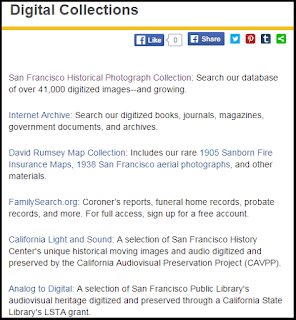![Abby Smith Rumsey, author of When We are No More: How Digital Memory is Shaping the Future. [Provided by the author]](https://blogger.googleusercontent.com/img/b/R29vZ2xl/AVvXsEhaZGR2fjRXBYwY8XJjIE_z2saDbERZirShfwSvH01g05MNOFUJF8KkFWG0BMYxfrEJtgPSOqQipR5dd5Ovqu0b9LGmDKtwggPnlAhOu3PsQQ8XzGbsilVNnu44R6ErFHlikZhRQWCHwnzI/s320/abby-032web.jpg) |
| Abby Smith Rumsey |
Abby Smith Rumsey is an historian, focusing on how ideas and information technologies shape perceptions of history, time, and of personal and cultural identity. She served as director of the Scholarly Communication Institute at the University of Virginia, and has advised universities and their research libraries on strategies to integrate digital information resources into existing collections and services.
In anticipation of her visit to the San Francisco Main Library, Abby Smith Rumsey has written a guest blog post for the San Francisco History Center's blog.
INTO THE FUTURE
In the 1990s, those of us working in history centers, libraries, archives, and museums all knew digital technologies would profoundly affect the future of our institutions. But how? It was impossible to know. I was at the Library of Congress at the time. We were digitizing our collections onto CD-ROMs. Tech companies were selling gold CD-ROMS as the optimal preservation format, the one to last for the ages. Regrettably, the playback machines they require did not. This was before Mosaic, before the World Wide Web, before search engines, e-books, social media, wireless connectivity, Big Data, and smart phones. I don’t recall anyone at the time predicting they were in our future, any more than the inventors of the ENIAC believed that computers would one day be a phone, a camera, a music system, a book reader, and a calculator—and fit in a shirt pocket.
 |
| Digital storage from days of yore. |
Today, webpages last an average of 100 days. Not only is the opportunity for assessing digital content’s value vanishingly small, but there is too much to sort through. Digital is the default mode of recording and getting access to everything, from videos (today’s home movies shared with the world), to blogs and Facebook updates (today’s diaries, journals, letters, and postcards to friends), to interactive maps, reference books, and so forth. Does that mean that history centers and libraries face obsolescence?
The answer is no. On the contrary, they are more valuable than ever. But that doesn’t mean that their transition to the digital age is simple, a matter merely of passive evolution, guaranteed to happen and guaranteed to have a happy ending.
 |
| Some of the digital collections of the San Francisco History Center. |
There is no doubt that local and regional libraries will be richer in content than ever because the Internet allows distributed, networked collecting. The new model of the library in the digital age is one of deeper networks of cooperation with other libraries, to cope with the scale of digital information being produced. Best of all, the new-model digital library will rely on ever deeper networks of community members, individuals and groups, to identify and collect digital materials important to them. These collectors can then be networked through the library to other communities. SFPL can collaborate with local organizations, such as the Internet Archive, and also the Digital Public Library of America with national and international reach. All it takes is community participation. The greater the community participation, the greater the access to truly diverse cultures now and into the future.
Comments
Post a Comment